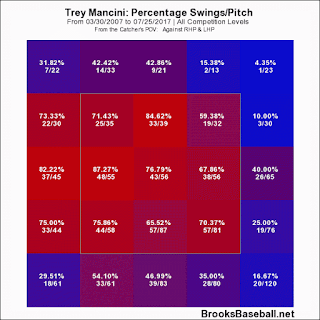Today, Mancini ranks as the 38th best rookie since 2017 in wRC+, a measure of pure hitting ability. His 127 wRC+ indicates that he's batting 27% better than the league as a whole, similar to the offensive performance put up by Francisco Lindor, Mookie Betts, and George Springer in their rookie seasons.
Earlier articles on this very website pointed to Mancini's very high HR/FB rate as a cause for his offensive performance, and a possible area of regression. When Mancini started the season, his 70% HR/FB rate was unsustainable, and it has fallen back to earth - kind of. His current 21.7% rate is still very high, 27th highest in the league among qualified hitters, but well within the range of an excellent power hitter.
However, Mancini hits ground balls too frequently to turn this HR/FB rate into the kind of attention that fellow rookie Aaron Judge is receiving. 50.7% of balls put into play by Mancini are ground balls, the 22nd highest rate in the league and mostly similar to league-average or below-average hitters.
As shown in the above batted ball trajectory chart, Mancini hits as many balls at steep downward angles (ie, into the dirt) as he does flat balls that are likely easily fielded grounders and balls at the 15 to 20 degree angle that are the most likely to be hits.
When hitting line drives and fly balls, the most preferable batted ball types, Mancini's average exit velocity of 96.4 miles per hour ranks 19th in the league this season. Of course, Mancini's average exit velocity is weaker when considering all batted ball types because he hits ground balls so frequently.
Notably, Mancini's power extends to all fields. Observe his spray chart, color-coded by exit velocity:
On balls in play that Mancini gets a solid bat on, he's generally hitting them to all fields. His weakly pulled grounders are not atypical for power hitters (and are the basis for shifting the infield against left-handed ones). That he hits line drives to all fields is notable, and promising for continued batting average success.
Most of the pitches Mancini sees are low and away. Most likely related: Mancini generally hits ground balls on pitches low and away that he puts into play. Fortunately, Mancini appears to exhibit a decent eye, swinging primarily at pitches middle and in:
While he has strong ground ball tendencies against pitches in all locations, Mancini is more likely to hit these middle-in pitches for fly balls, and hits line drives most frequently on pitches in the middle and bottom thirds of the zone. That he does a relatively good job of avoiding pitches that he almost definitely hits on the ground is another good sign for a 25-year-old who will likely rely on his bat to be a successful Major League ballplayer. If Mancini can avoid hitting as many balls into the dirt, he could improve his offensive performance even further.
Mancini is the Orioles' second best hitter this season in wRC+, and showing potential for consistent hitting and clear opportunities for improvement. The latter might not sound as positive, but identifying areas of weakness is a necessary first step toward improvement. If Mancini can reduce his GB% to something resembling the league average, or average among other power hitters, the Orioles might have a very scary hitter on their hands.
If the Orioles knew what they had on their hands in Mancini, they might not have been as eager to sign Chris Davis or Trumbo to longer-term and higher-priced contracts. As it stands, the Orioles have a good, young, controlled power hitter on their hands to fill the role of 1B/DH/OF-only-if-you-have-to.



3 comments:
In terms of OF defense, Mancini is still very much learning.
Has he logged enough innings to get a sense of where his defense is going to end up. Certainly better than Trumbo, but what's his ceiling?
"Left fielder Trey Mancini has been one of the lone bright spots in the Baltimore Orioles 2017 campaign."
Correct. I would also add in Castro who has pitched surprisingly well and is only 22, Blier and Hart who have solidified the lefty reliever role, Givens who has emerged as an elite level reliever, and Schoop's emergence as a hitting machine. You also have to include the breakout of Austin Hays in the minors. These young players provide at least some glimmer of hope that the O's can rebound next season.
One more thought: The O's better not trade Castro in search for another Wade Miley type. It would put my fandom with this team on the brink.
Post a Comment